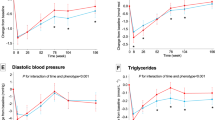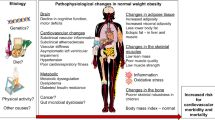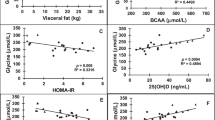Abstract
Young adulthood is often a period of substantial weight gain increasing risk for obesity and cardiometabolic disease. Uric acid (UA), a clinical marker of oxidative stress, is associated with cardiometabolic dysfunction in established CVD, type 2 diabetes, and CKD. Yet, few trials have examined UA as a predictor of cardiometabolic risk in young, healthy populations, particularly in the context of weight gain prevention intervention. The purpose of this ancillary study was to examine UA in the Study of Novel Approaches to Weight Gain Prevention (SNAP), a randomized, controlled trial of weight gain prevention strategies in young healthy adults. UA was examined as a predictor of weight and cardiometabolic outcomes over 6 years; the impact of weight gain prevention interventions on UA was also examined. We found that higher baseline UA was a significant predictor of less favorable BMI, triglycerides, HDL, glucose, insulin, and HOMA, independent of age, sex, baseline weight, baseline level of the outcome variable, and weight gain prevention intervention. Additionally, ≥1% weight loss was associated with lower UA. UA is a promising biomarker for future weight gain and cardiometabolic risk in young adults that may respond to weight gain prevention.
Clinical trial registration: clinicaltrials.gov identifier NCT01183689
This is a preview of subscription content, access via your institution
Access options
Subscribe to this journal
Receive 12 print issues and online access
$259.00 per year
only $21.58 per issue
Buy this article
- Purchase on Springer Link
- Instant access to full article PDF
Prices may be subject to local taxes which are calculated during checkout
Similar content being viewed by others
References
Velho S, Paccaud F, Waeber G, Vollenweider P, Marques-Vidal P. Metabolically healthy obesity: different prevalences using different criteria. Eur J Clin Nutr. 2010;64:1043–51.
Alberti G, Zimmet P, Shaw J, Bloomgarden Z, Kaufman F, Silink M. Type 2 diabetes in the young: the evolving epidemic: the international diabetes federation consensus workshop. Diabetes Care. 2004;27:1798–811.
Grygiel-Górniak B, Mosor M, Marcinkowska J, Przysławski J, Nowak J. Uric acid and obesity-related phenotypes in postmenopausal women. Mol Cell Biochem. 2018;443:111–9.
El Ridi R, Tallima H. Physiological functions and pathogenic potential of uric acid: a review. J Adv Res. 2017;8:487–93.
Yeo C, Kaushal S, Lim B, Syn N, Oo AM, Rao J, et al. Impact of bariatric surgery on serum uric acid levels and the incidence of gout—a meta-analysis. Obes Rev. 2019;20:1759–70.
Dulloo AG, Montani JP. Pathways from dieting to weight regain, to obesity and to the metabolic syndrome: an overview. Obes Rev. 2015;16:1–6. Suppl 1
Wing RR, Tate D, Espeland M, Gorin A, LaRose JG, Robichaud EF, et al. Weight gain prevention in young adults: design of the study of novel approaches to weight gain prevention (SNAP) randomized controlled trial. BMC Public Health. 2013;13:1–5.
Wing RR, Tate DF, Espeland MA, Lewis CE, LaRose JG, Gorin AA, et al. Innovative self-regulation strategies to reduce weight gain in young adults: the Study of Novel Approaches to Weight Gain Prevention (SNAP) randomized clinical trial. JAMA Intern Med. 2016;176:755–62.
Jakobsen JC, Gluud C, Wetterslev J, Winkel P. When and how should multiple imputation be used for handling missing data in randomised clinical trials—a practical guide with flowcharts. BMC Med Res Methodol. 2017;17:162.
Cicero AF, Rosticci M, Tocci G, Bacchelli S, Urso R, D’Addato S, et al. Serum uric acid and other short-term predictors of electrocardiographic alterations in the Brisighella Heart Study cohort. Eur. J. Intern Med. 2015;26:255–8.
Cicero AFG, Fogacci F, Giovannini M, Grandi E, Rosticci M, D’Addato S, et al. Serum uric acid predicts incident metabolic syndrome in the elderly in an analysis of the Brisighella Heart Study. Sci Rep. 2018;8:11529.
Zhang ML, Gao YX, Wang X, Chang H, Huang GW. Serum uric acid and appropriate cutoff value for prediction of metabolic syndrome among Chinese adults. J Clin Biochem Nutr. 2013;52:38–42.
Soltani Z, Rasheed K, Kapusta DR, Reisin E. Potential role of uric acid in metabolic syndrome, hypertension, kidney injury, and cardiovascular diseases: is it time for reappraisal? Curr Hypertens Rep. 2013;15:175–81.
Dawson J, Wyss A. Chicken or the egg? Hyperuricemia, insulin resistance, and hypertension. Hypertension. 2017;70:698–9.
Juraschek SP, McAdams-Demarco M, Miller ER, Gelber AC, Maynard JW, Pankow JS, et al. Temporal relationship between uric acid concentration and risk of diabetes in a community-based study population. Am J Epidemiol. 2014;179:684–91.
Wing RR, Espeland MA, Tate DF, Perdue LH, Bahnson J, Polzien K, et al. Changes in cardiovascular risk factors over 6 years in young adults in a randomized trial of weight gain prevention. Obesity. 2020;28:2323–30.
Battelli MG, Bortolotti M, Polito L, Bolognesi A. The role of xanthine oxidoreductase and uric acid in metabolic syndrome. Biochim Biophys Acta Mol Basis Dis. 2018;1864:2557–65.
Saito H, Tanaka K, Iwasaki T, Oda A, Watanabe S, Kanno M, et al. Xanthine oxidase inhibitors are associated with reduced risk of cardiovascular disease. Sci Rep. 2021;11:1380.
Ying H, Yuan H, Tang X, Guo W, Jiang R, Jiang C. Impact of serum uric acid lowering and contemporary uric acid-lowering therapies on cardiovascular outcomes: a systematic review and meta-analysis. Front Cardiovasc Med. 2021;8:641062.
Virdis A, Masi S, Casiglia E, Tikhonoff V, Cicero AFG, Ungar A, et al. Identification of the uric acid thresholds predicting an increased total and cardiovascular mortality over 20 years. Hypertension. 2020;75:302–8.
Author information
Authors and Affiliations
Contributions
LMLC performed UA assays, analyses, and wrote the manuscript. JM reviewed assay results, conducted analyses, and wrote the manuscript. RW, DFT, MAE, and BEB reviewed analyses, and/or edited manuscript.
Corresponding author
Ethics declarations
Competing interests
RW is on the scientific advisory board for NOOM. No other authors report conflicts of interest.
Additional information
Publisher’s note Springer Nature remains neutral with regard to jurisdictional claims in published maps and institutional affiliations.
Supplementary information
Rights and permissions
About this article
Cite this article
Corso, L.M.L., Wing, R.R., Tate, D.F. et al. Uric acid as a predictor of weight gain and cardiometabolic health in the Study of Novel Approaches to Weight Gain Prevention (SNAP) study. Int J Obes 46, 1556–1559 (2022). https://doi.org/10.1038/s41366-022-01131-1
Received:
Revised:
Accepted:
Published:
Issue Date:
DOI: https://doi.org/10.1038/s41366-022-01131-1



